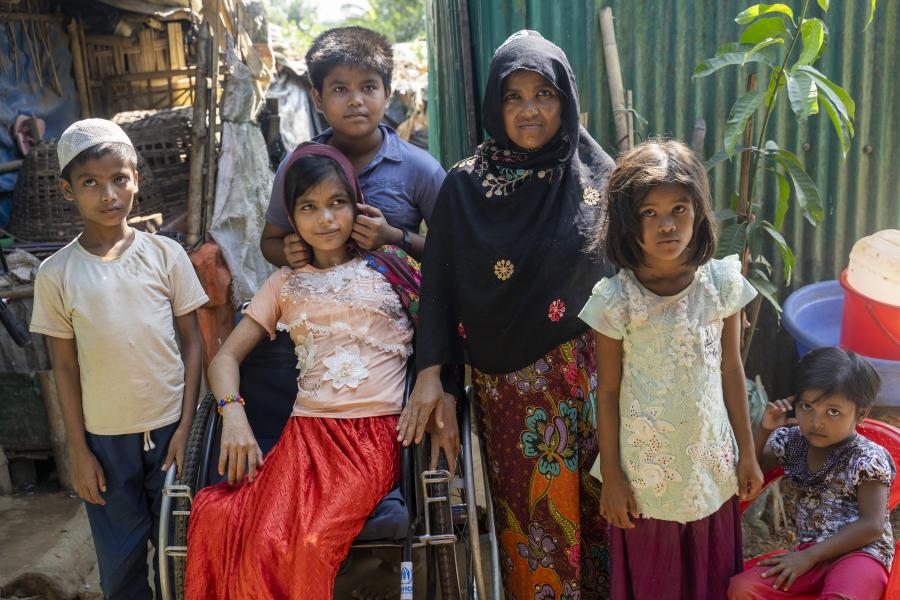2024 population planning figures
15.6 million forcibly displaced and stateless people¹ | 12% of global total

Regional overview
2024 begins against a bleak backdrop in Asia and the Pacific: frequent humanitarian crises and climate-induced emergencies, crippling insecurity and economic instability, and a decline in funding to support a projected 15.6 million forcibly displaced and stateless people in the region, where two complex situations are major causes of forced displacement and statelessness: Afghanistan and Myanmar.
Across the region, UNHCR will seek the inclusion and empowerment of people who have been forced to flee and will aim to bring a sustainable end to their forced displacement, while easing the pressure on host communities. In 2024, UNHCR will prioritize education, livelihoods, health, mental health and psychosocial support. It will bolster multi-stakeholder approaches and partnerships, joining forces to advocate on behalf of displaced people in ways that enhance their resilience and facilitate their inclusion in national systems, such as those achieved in the Islamic Republic of Iran.
In support of the Secretary-General’s Action Agenda on Internal Displacement, UNHCR will assist in stabilizing the two big internally displaced populations in the region and will support protection-sensitive IDP returns. In Afghanistan, 60,000 refugees and 300,000 IDPs could return in 2024, and UNHCR will continue its role as a catalyst for attracting investment into the 80 Priority Areas of Return and Reintegration. In line with the priorities of the Global Compact on Refugees to advance long-term planning, UNHCR will shift from a one-year to a multi-year inter-agency Regional Refugee Response Plan for Afghanistan to promote improved access to asylum and protection, and to support resilience, inclusion and solutions.
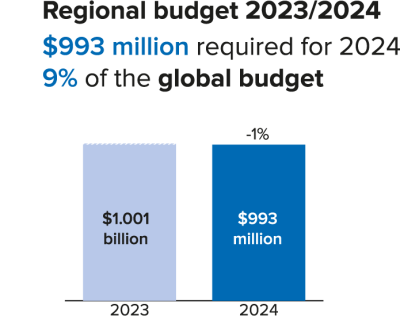
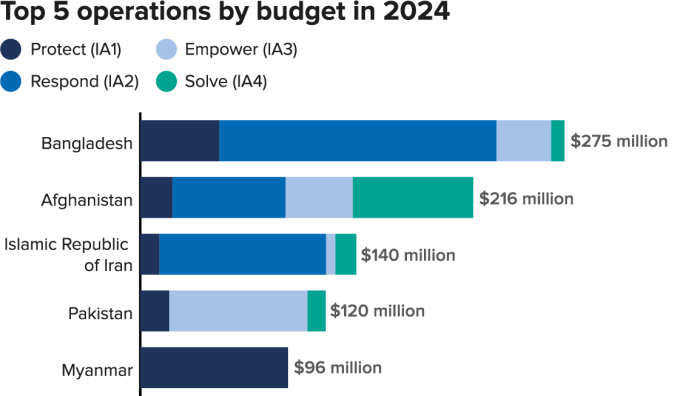
Displacement in Myanmar is expected to push the IDP population up to 2.3 million in 2024. UNHCR will work to secure more predictable and regular access in 2024 to meet the basic needs of those displaced, both inside Myanmar and in neighbouring countries. UNHCR will engage local NGOs and community-based organizations to scale up the delivery of assistance and bolster protection and displacement monitoring.
Until conditions allow large-scale voluntary returns, UNHCR will work with partners to support the almost 1 million Rohingya refugees in Bangladesh. UNHCR will continue pursuing comprehensive approaches to solutions for Rohingya refugees and access to education and portable skills development opportunities. It will also support mental health and psychosocial support programmes and child protection services for 47,000 children, adolescents and caregivers.
UNHCR will advocate for a comprehensive regional response to address the rise in onward movements in South-East Asia.
Overall, an estimated 730,000 vulnerable refugees in the region are in need of resettlement. UNHCR will seek resettlement opportunities for 31,400 Rohingya and 12,800 Afghan refugees in 2024 and will shore up support for complementary pathways for refugees in Bangladesh, India, Indonesia, the Islamic Republic of Iran, Malaysia and Pakistan. It will seek solutions for more than 90,000 Myanmar refugees in Thailand, for whom voluntary repatriation remains suspended. UNHCR will also enhance partnerships and activities to enable additional opportunities for solutions through family reunification, labour mobility, education and sponsorship.
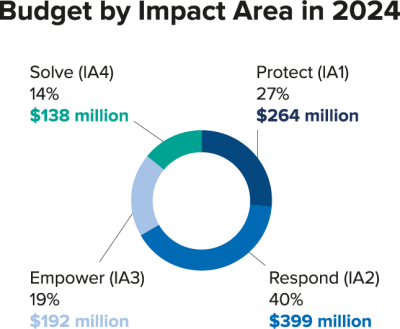
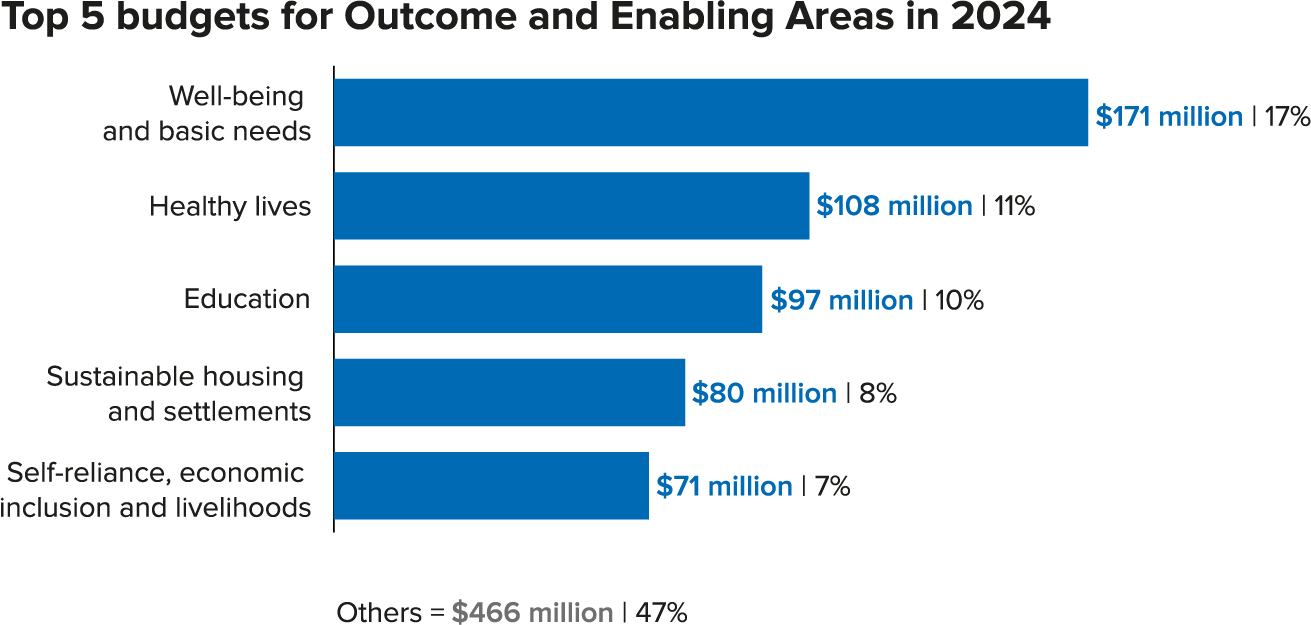
In 2024, Asia is expected to host over half of all the people under UNHCR's statelessness mandate. Central Asian countries have made significant advances to end statelessness, with Uzbekistan alone confirming the nationality of over 10,000 individuals in 2022, and UNHCR will accelerate advocacy for States to accede to the statelessness conventions and address gaps in birth registration and national legal frameworks for citizenship, in line with the “Global action plan to end statelessness 2014–2024”. UNHCR will assist 1,000 stateless persons and those with undetermined nationality with confirmation or acquisition of nationality in Kazakhstan, Kyrgyzstan, Turkmenistan and Uzbekistan. In Thailand, UNHCR will seek to raise 3,000 people's awareness of statelessness issues, including government partners.
With climate change disproportionately affecting the region, UNHCR will advance its regional "Climate action plan 2023–2025” by emphasizing the need to include forcibly displaced and stateless people in national adaptation and disaster risk reduction plans, promoting climate-smart and sustainable environmental programming, investing in renewable energy, and mobilizing support through a risk-based approach.
For the latest operational and funding updates on the Asia Pacific region check this page.
